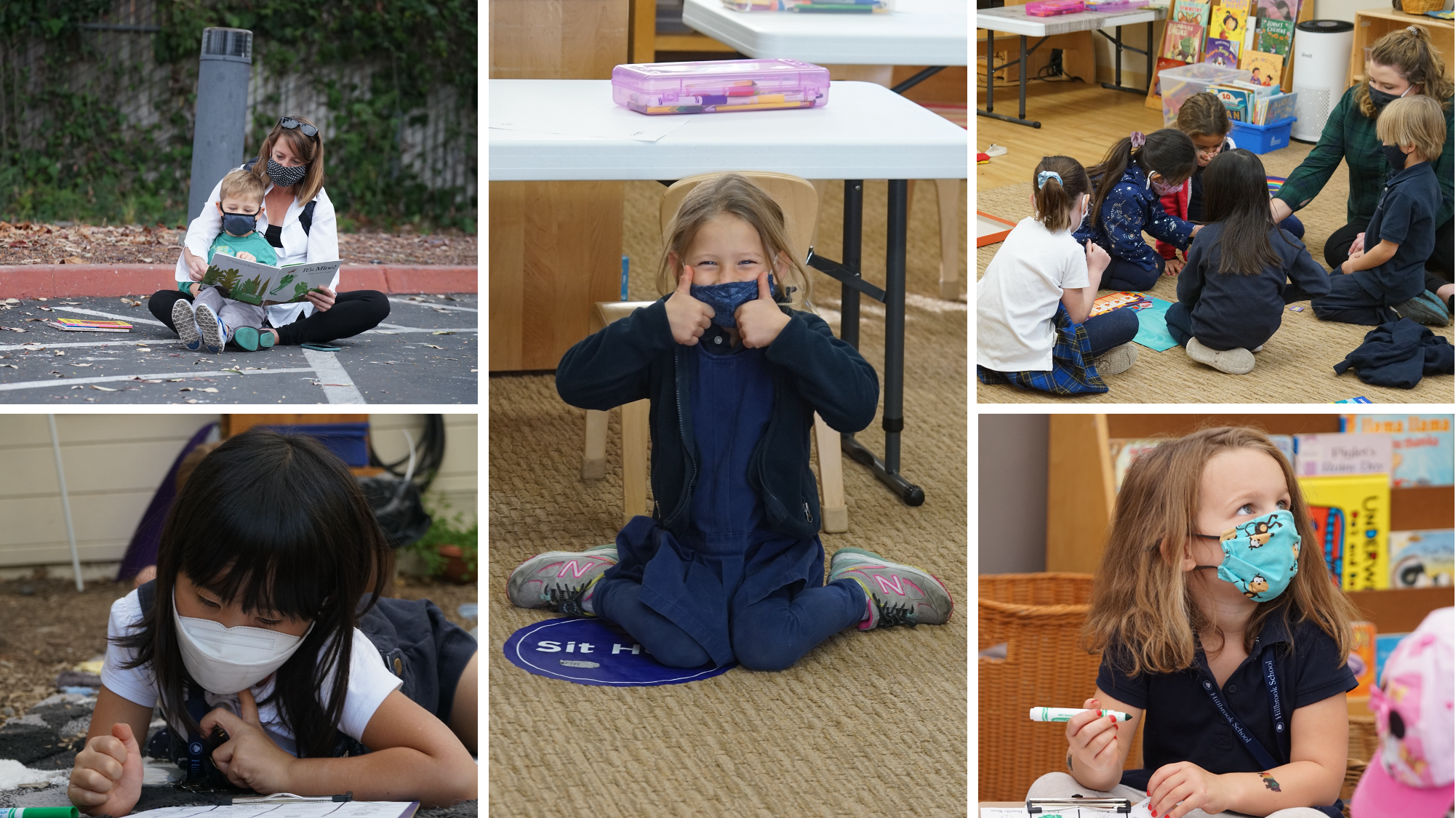by Colleen Schilly, Associate Head of School, Ilsa Dohmen, Director of Teaching and Learning, and Kelly Scholten, Associate Head of Lower School
“If you are a dreamer, come in,
If you are a dreamer, a wisher, a liar,
A hope-er, a pray-er, a magic bean buyer…
If you’re a pretender come sit by my fire
For we have some flax-golden tales to spin.
Come in!
Come in!”
― Shel Silverstein, Where the Sidewalk Ends
“It was a music more tangible than form or sight…It seemed to travel with her, to sweep her aloft in the power of song, so that she was moving in glory among the stars, and for a moment she, too, felt that the words Darkness and Light had no meaning, and only this melody was real.” – A Wrinkle in Time
Throughout their time at Hillbrook, students wield language for time travel and wonder, to walk in others’ shoes, to hone their self-awareness, and to explore a world of characters and experiences different from their own. We write, read, speak, and listen as ways to understand ourselves, our families, our communities, and our world more clearly. We use a wide range of texts to explore issues that matter to us and our peers. But how do we get started? What skills do young learners need to access the rich world of text?
The ability to voyage, empathize, or have your mind changed by reading can only happen as a product of word recognition (decoding) and language comprehension. Dr. Hollis Scarborough created the “reading rope” model for visualizing the distinct skills required for literacy. The rope has two main cords, one focused on word recognition, the other on language comprehension. Within each cord, a number of skills are learned separately, then gradually woven together as the child gains fluency and speed. The language comprehension cord comprises perhaps the more familiar parts of literacy: vocabulary, syntax, mechanics, print concepts, background knowledge, and more. The word recognition cord contains three main subskills that are often conflated:
- Phonemic awareness: the understanding that words are made of individual sounds
- Decoding & encoding (phonics): the understanding that letters represent sounds and can be read and written to form words
- Sight recognition: using memorization & recall to identify frequent but irregularly-spelled words
Early on, as a reader is developing these word recognition skills to get the text off the page, most of their cognitive effort and working memory is devoted to the decoding part of reading. As the reader becomes a more fluent decoder, they can spend that cognitive effort on the work of language comprehension and building understanding from the texts they read.
Hillbrook is constantly auditing and evolving our programs to make them ever better. In our most recent English/Language Arts Audit, the team recommended that teachers and administrators investigate current methods for word study, and review evidence-based techniques for teaching each strand of the reading rope. Our basis in Fundations curriculum and materials means our students are already getting strong phonics instruction, anchored in scaffolded, grade-appropriate outcomes which are research-backed and Common Core aligned. Students learn what sound(s) each letter represents, how to write and read letters, and, with time, all six syllable types and how the rules for each have predictable exceptions. But based on classroom observations and meetings with teachers across grades, we sought out and implemented a new program for teaching phonemic awareness this school year:
Teacher: Say ‘sale’
Students: ‘sale’
Teacher ‘Without /l/ what’s left is?’
Students: ‘say’
Phonemic awareness is the understanding that spoken words are made up of individual sounds called phonemes. A child who has phoneme proficiency is able to isolate & blend sounds, segment a word into its component sounds, and delete, add, or substitute sounds in a word to create a new word. Although phonemic awareness and phonics work together, and are both essential building blocks to word recognition, they are different skills that need to be separately taught. Phonemic awareness focuses on just sounds or phonemes. For example, “When I say ‘bat’, what sounds do you hear? /b/ /a/ and /t/”— just the sounds. Concurrently, during phonics instruction, our focus switches to graphemes, or letters, that represent each sound. The /b/ /a/ /t/ sounds in phonemic awareness become the letter representations of those sounds, b – a – t in phonics.
Think of it in terms of sound and vision: while phonemic awareness instruction is auditory only, strengthening the understanding of phonemes through the sounds of spoken language, phonics lessons link those sounds with their visual representation through written letters. Simply put, phonemic awareness helps students understand that words are made up of sounds, while phonics attaches letters to those sounds.
Teacher: The word is “find” if I take the /f/ sound out I’m left with…
Students: -ind!
Teacher: The word is leak, if I take the /l/ sound out I’m left with..
Students: -eek!
– 1st Grade Heggerty Lesson at Hillbrook (video here)
Developing an ear for language is an essential early step towards reading, and has been proven to increase both fluency and comprehension. The proof is in the phonemes!
All students at Hillbrook now receive systematic phonemic awareness instruction (using Heggerty) through 2nd grade, when most students begin to master each phonemic awareness skill—rhyming, onset fluency, blending, isolating, segmenting, adding, deleting & substituting—and can focus their efforts on other parts of the reading rope. Concurrently, students are learning phonics (primarily using Fundations), sight word recognition (memorization and recall of frequent, irregularly-spelled words), and all skills of the language comprehension cord (through Workshop-based instruction, including Calkins Readers & Writers Workshop & Story Workshop) as part of their daily, whole-class literacy blocks.
Eager to learn more about the building blocks of literacy? Check out this curated set of articles and podcasts about the science of reading and look out this Fall for a Family Education Event on campus to see all the strands in action!

